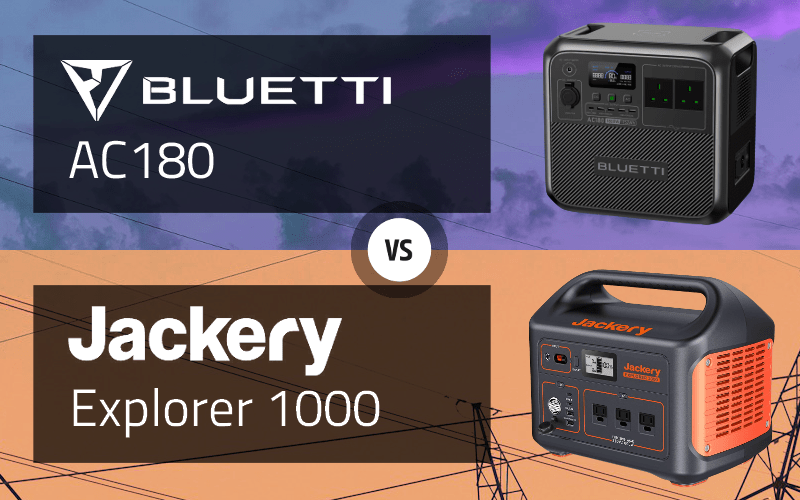In this comparison, we’re putting the Bluetti AC180 vs Jackery 1000 (both the original Jackery Explorer 1000 and Plus models) portable power stations head-to-head. We will start the article by doing a general overview of the power stations, before comparing the key features that differentiate them.
Both Bluetti and Jackery are very respected and well-trusted brands in the solar generator industry, and the AC180 and Explorer 1000 are some of the brands’ most popular models, so it’s out opinion that you can’t really go wrong with either – but our focus is to help you decide which portable power station best meets your needs.
(Note: be sure to check the Bluetti and Jackery product pages for up-to-date prices. Sales prices may vary from the time of writing this blog post.)
A portable power station is a compact, off-grid system which uses a rechargeable battery to provide electricity. Compared to power banks, which often only provide USB outlets, portable power stations have a higher output, a larger capacity, and additional outlets (e.g. AC/wall) so that they can power a range of appliances.
Unlike simple batteries, portable power stations have additional components, such as a charge controller and an inverter. The charge controller regulates the power input and conversion from AC or DC sources, while the inverter converts the stored DC power back into AC power, which allows it to power standard appliances.
When selecting a portable power station, you should consider the following key metrics:
- Battery Capacity (Wh): The total energy capacity of the portable power station, which determines how long it can power devices (measured in Watt hours).
- Output (W): The maximum power output of the portable power station, which affects the type and number of devices it can run simultaneously.
- Battery chemistry: While this is tied closely to capacity and charging speed, you should always consider the battery chemistry of your portable power station, as this influences not only the durability of the product, but also the portability and safety. The most stable and hence safe battery type is the LiFePO4 (lithium iron phosphate), which is also the heaviest.
- Charging speed: How quickly the station can be recharged, which varies based on the charge controller’s efficiency and the type of recharging (e.g. AC, solar, car).
- Lifespan: How many charge/discharge cycles the portable power station can go through before the battery capacity is reduced to a specified percentage (e.g. 500 cycles to 80% capacity).
- Portability: A combination of factors including the weight, size, and ease of carrying. Typically, the higher the battery capacity of a portable power station, the heavier and larger it will be. Some larger models feature wheels for better mobility.
- Additional features: Includes the number and types of output ports (e.g. USB, AC), charging options (e.g. AC, solar, car), and extra functionalities like app integration for remote management.
Bluetti AC180 vs Jackery 1000: General Comparison
BLUETTI AC180
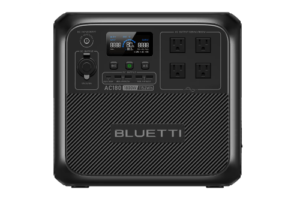
Price (UK): £699 (£1,099)
Price (US): $999
Power (W): 1800 (2700 power lifting)
Capacity (Wh): 1152
Cell chemistry: LiFePO₄
Weight: 16 kg (35.3 lbs)
Dimensions: 340 x 247 x 317 mm
(13.4 x 9.7 x 12.5 in)
Warranty: 5 years
Reviews: ⭐⭐⭐⭐⭐ 4.9 (237)
Life cycles: 3,500+ cycles to 80% original capacity. Shelf-life: Recharge to 80% every 3-6 months.
Solar input: 500W
Charging times:
AC (1,440W): 1.3-1.8 hours
Car (100W/200W): 12.3 hours / 6.5 hours
Solar (500W): 2.8-3.3 hours
Jackery Explorer 1000

Price (UK): £599 (£1,049)
Price (US): $999
Power (W): 1000 (2000 surge)
Capacity (Wh): 1002
Cell chemistry: Lithium-ion
Weight: 10 kg (22 lbs)
Dimensions: 333 x 233 x 283 mm (13.1 x 9.2 x 11.1 in)
Warranty: 3 years (2 + 1 year extended warranty)
Reviews: ⭐⭐⭐⭐⭐ 4.6 (254)
Life cycles: 500 cycles to 80% original capacity.
Solar input: 126W
Charging times:
AC adapter: 7.5 hours
Car adapter (12V): 14 hours
Solar (1x/2x 100W): 13.5 hours / 10 hours
(Extend warranty automatically applies when purchasing from Jackery website)
Jackery Explorer 1000 Plus
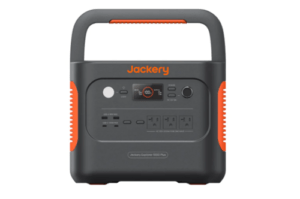
Price (UK): £1,149
Price (US): $1,199
Power (W): 2000
Capacity (Wh): 1264
Cell chemistry: LiFePO₄
Weight: 14.5 kg (32 lbs)
Dimensions: 356 x 260 x 283 mm (14.0 x 10.2 x 11.1 in)
Warranty: 5 years (3 + 2 year extended warranty)
Reviews: ⭐⭐⭐⭐⭐ 5 (15)
Life cycles: 4000 cycles to 70% capacity
Solar input: 200W
Charging times:
AC adapter: 1.7 hours
Car adapter (12V): 7 hours
Solar: 3 hours
(Extend warranty automatically applies when purchasing from Jackery website)
Customer Feedback
Bluetti AC180 reviews
Key Feedback:
- Great performance: Many customers praised the AC180 for its strong performance, particularly its ability to handle high-wattage appliances without difficulty.
- Versatility and portability: Many praised the AC180’s versatility, being used in various environments such as camping, road trips, and as a home power backup.
- Rapid charging: Many reviews mention the very quick recharging, whether from solar panels, AC, or DC.
- App functionality: Many users mention the app is easy to use and connect, and has lots of helpful features.
- Aesthetics and practical design: Many customers mention the AC180’s design as compact, aesthetically pleasing, and easy to store and transport.
Pros:
- ✅ Portable and convenient: Compact size and ease of transport, making it ideal for a variety of settings, from home offices to remote camping sites.
- ✅ High quality build: Excellent design, build, and durability of the generator which means it runs reliably.
- ✅ Effective for emergency and outdoor use: Very effective in emergency power outages and for outdoor recreational activities, powering essential devices and appliances.
- ✅ User-friendly interface: It is simple to operate and has a helpful app which improves user experience, making it easy to monitor and control power usage.
- ✅ Fast and efficient charging: It charges quickly and efficiently, capable of being powered up via multiple sources which users find very convenient.
Cons:
- ❌ Incomplete UPS functionality: Some users mention that the UPS (Uninterruptible Power Supply) feature does not behave as expected, using battery power before AC power is lost. Some suggest using YouTube to diagnose and fix these problems as the Bluetti website is lacking.
- ❌ Heavy for some users: Although portable, the AC180 is quite heavy for some users’ tastes.
- ❌ Limited documentation and support: Some customers think there is insufficient documentation for setting up and operating the generator, leading to reliance on online forums and customer support.
- ❌ Initial calibration issues: A small number of users experienced problems with battery calibration, requiring them to drain the battery completely to correct the charge level display.
- ❌ Communication and delivery issues: Some customers express dissatisfaction with the communication regarding order and delivery status.
Jackery Explorer 1000 reviews
Key Feedback:
- Great performance: Many users are very impressed by the Explorer 1000’s reliable performance in a variety of settings, including home, outdoor, and emergency use.
- Versatility and portability: Like the AC180, the Explorer 1000 is versatile and can be used in various environments, proving useful for both recreational and emergency power needs.
- Ease of use: Many customers mention the Explorer 1000’s simplicity and user-friendliness.
- Solar compatibility: There is frequent positive feedback about its compatibility with solar panels, although some note the need for specific types or additional panels for optimal charging.
- Good customer service: Several users were very happy with Jackery’s customer service.
Pros:
- ✅ Efficient and powerful: Capable of running high-demand devices like CPAP machines, fridges, and power tools, making it very useful for both backup and recreational uses.
- ✅ Compact and lightweight: Typical of Jackery products, many users describe its design as compact and easy to transport, making it perfect for portable needs.
- ✅ Solar panel integration: Works well with solar panels, which is especially useful during prolonged outdoor activities or power outages.
- ✅ High quality build: Users are satisfied with the build quality, saying the Explorer 1000 feels sturdy and well-made.
- ✅ Rapid charging: Although not as fast as the Bluetti AC180, many users are happy with its fast charging capabilities.
Cons:
- ❌ Confusion over solar panel compatibility: There was some confusion and dissatisfaction with the solar panel compatibility and charging times, noting that different models have specific requirements that aren’t always clear. For example, some noted issues with connector types and the necessity of multiple panels for efficient charging. Some suggested the promotional materials should more accurately reflect the real-world charging times and requirements to avoid confusion and ensure optimal use.
- ❌ Inconsistent information: As mentioned in the point above, some feedback mentioned ‘misinformation’ or unclear details about charging times and the necessity for additional solar panels, which can lead to unexpected additional costs.
- ❌ Limited heavy appliance use: Despite its high capacity, there are limitations for running very high-wattage appliances or for extended periods, which might not meet everyone’s needs.
- ❌ Customer support issues: While many report excellent customer service, a few users have had less satisfactory experiences, particularly with communication and response times.
Jackery Explorer 1000 Plus reviews
Key Feedback:
- Fast delivery and setup: Many users reported a quick delivery and easy setup process of the Explorer Plus 1000, and that it’s ready to go out-of-the-box.
- Reliable performance: Frequently praised for its reliable performance, particularly during power outages, with the ability to handle high-demand appliances and multiple devices simultaneously.
- Build quality and design: High quality build and design aesthetics (sturdy and user-friendly).
Pros:
- ✅ Quick charging capability: The unit charges quickly via AC, with users mentioning it only takes about 2 hours to charge fully from a low battery state.
- ✅ Expandability: The ability to expand capacity with external batteries is very useful, especially for extended use during power outages or long camping trips.
- ✅ Helpful app interface: The Jackery app, which allows for remote monitoring and control, add convenience and enhanced usability.
- ✅ Durable LiFePO4 battery: Reviews mention the LiFePO4 battery is a big benefit, as it has greater longevity and safety compared to other battery types.
- ✅ Versatile charging options: Users are happy with the multiple charging options, including solar, and also report fast charging times.
Cons:
- ❌ Weight: Although it offers more capacity, the Explorer Plus 1000 is heavier than other models.
- ❌ Dependency on smart technology: Some users are annoyed by the need to use a smartphone app for some features, preferring a more standalone capability especially in situations where mobile service might be compromised.
- ❌ Complexity with additional batteries: The process of using and charging additional battery packs might be complex and requires better clarification, as the packs cannot operate independently and must be connected to the main unit for use.
- ❌ Limited standalone capability of battery packs: Without output ports, the additional battery packs cannot be used as standalone power sources, which limits their usability compared to the main unit.
Power Output
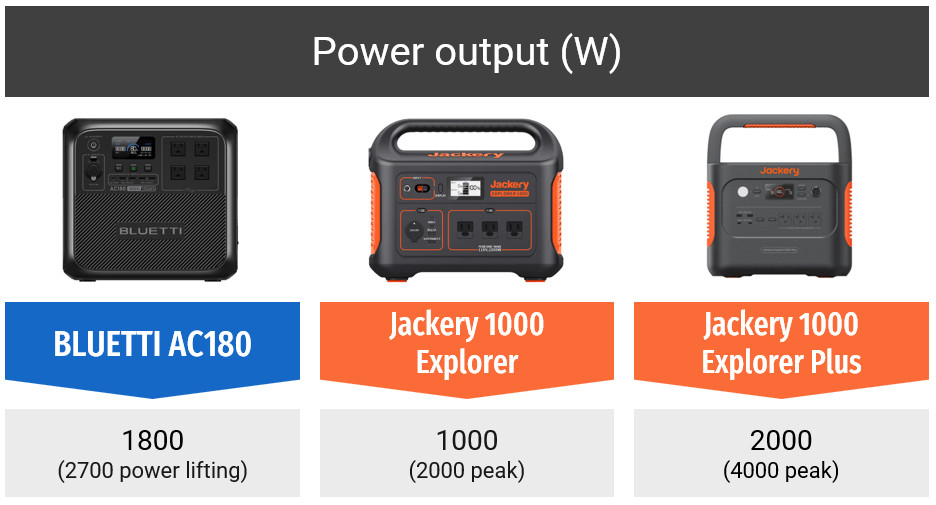
The Bluetti AC180 has an output of 1800W for continuous use, which increases to 2700W in its ‘Power Lifting Mode’, which allows it to run high-power heating devices, including space heaters, electric blankets, and hair dryers. However, it should be noted that the AC180 should NOT be used to run an air conditioner or washing machine, whether in Power Lifting Mode or not.
(If unfamiliar with Power Lifting Mode, one might wonder why one couldn’t simply use Power Lifting at all times. The answer is that Power Lifting Mode increases usable Watts by lowering the voltage. It is recommended to only use Power Lifting Mode on resistive loads.)
The Jackery Explorer 1000 has an output of 1000W, with a peak or surge power of 2000W. This means the AC output ports should only be used to power devices which operate continuously at 1000W or under, and the overall wattage should also stay within 1000W – otherwise the Explorer 1000 will turn off automatically.
The Jackery Explorer 1000 Plus has a continuous power output of 2000W, which steps up to 4000W for peak output. This 2000W inverter means you should be able to power most of your devices without problem.
All three models – the Bluetti AC180 and both Jackery Explorer 1000 models – allow simultaneous charging and discharging.
Capacity
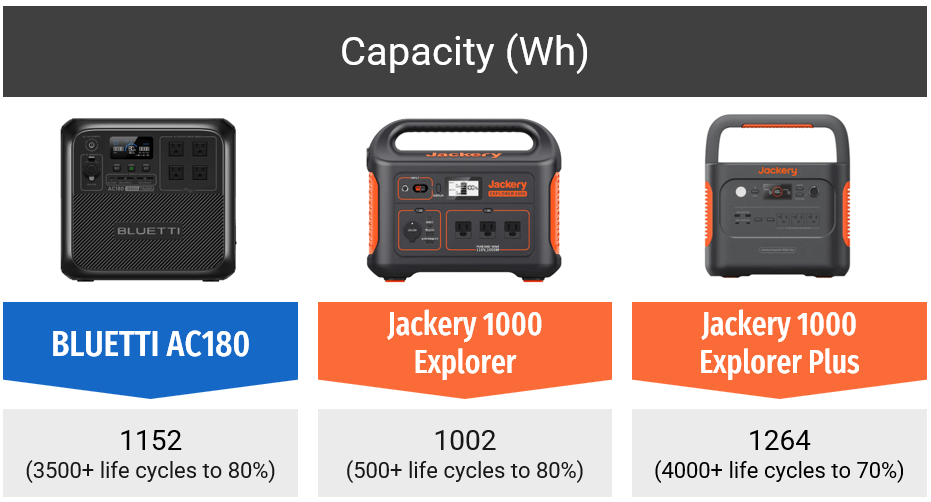
The Bluetti AC180 has a battery capacity of 1152Wh, with its LiFePO₄ battery lasting over 3500 cycles before dropping to 80% capacity. This makes it well-suited for longer-term use in scenarios like camping trips, road trips, or emergency home power backup. For increased capacity, the AC180 supports capacity expansion with B80 expansion batteries only.
The Jackery Explorer 1000 comes with a battery capacity of 1002Wh, although its Lithium ion battery means it has a cycle life of 500 cycles before dropping to 80% capacity. This means the Explorer 1000 is suitable for powering daily gadgets and smaller appliances – however it is not as long-lasting as the Explorer 1000 Plus or the Ac180.
The Jackery Explorer 1000 Plus has a battery capacity of 1264Wh, with its LiFePO₄ battery lasting 4000 cycles to 70% capacity. Its capacity can further be expanded up to 5000Wh with the addition of three external battery packs, making it exceptionally versatile for long-duration backup power, extensive outdoor use, and emergency situations.
Battery Type
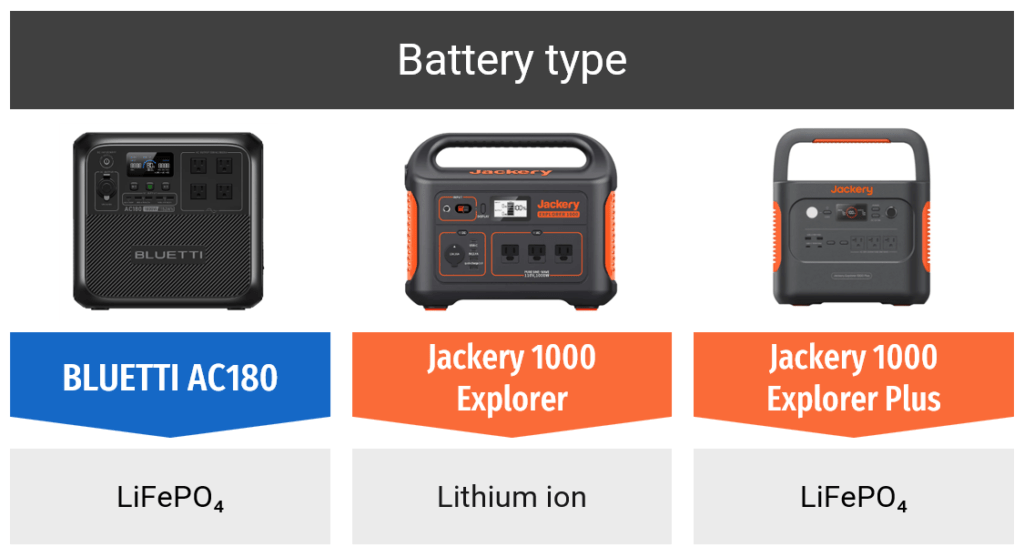
Whilst the Jackery 1000 Explorer uses a Lithium ion battery, both the Bluetti AC180 and Jackery 1000 Explorer Plus have LiFePO4 batteries. The LiFePO4 batteries (lithium iron phosphate, also called ‘LFP’) are always a win in our books, primarily due to their superior safety profile among other things.
LiFePO4 batteries are highly efficient, with a cycle life of 4-5 times longer than lithium ion batteries. They are also much less likely to overheat or catch fire, even when damaged (unlike their lithium ion counterparts), and come with built-in battery management systems to prevent overcharging.
The drawbacks to LiFePO4 batteries compared to lithium ion batteries are that they are heavier – lithium ion batteries are often popular choices for portable power stations due to their lighter weight. LiFePO4 batteries also have a higher upfront cost – however due to their durability and long life, they are more economic in the long run.
Variety of Output Ports
The Bluetti AC180 has a variety of output ports, providing versatile options for a range of devices, including 2x 230V/7.8A AC outlets (1,800W in total, 2,700W surge power), 1x USB-C port (100W max), 2x pairs USB-A port (5V/3A), 1x 12V DC car outlet (12V/10A), 1x wireless charging pad (15W Max). It uses a Pure Sine Wave inverter.
The Jackery Explorer 1000 has x3 AC outlets (110V, 60Hz, 1000W, with 2000W surge power), 2x USB-A outlets (5V/2.4A, Quick Charge 3.0 x1, 18W max), 2x USB-C outlets (5V, 9V, 12V up to 3A, 18W max), and 1x car outlet (12V/10A).
The Jackery Explorer 1000 Plus has 3x AC outlets (120V, 60Hz, 2000W, with 4000W surge power), 2x USB-A outlets (5V/3A, 18W max), 2x USB-C outlets (5V, 9V, 12V, 15V, 20V up to 5A, 100W Max), 1x car outlet (12V/10A), and bypass mode AC input/output (100-120V, 60Hz, 15A max) (where it passes AC power directly from its input to its output without storing it in the battery).
As mentioned above, all three models allow simultaneous charging and discharging.
Charging Options and Times

All three models provide charging options of AC (wall), solar, and car, although charging times vary.
The Bluetti AC180 offers three different AC charging modes, which each have their own charging times: Silent (260W, 4.9-5.4 hrs), Standard (around 1,000W, 1.7-2.2 hrs), and Turbo (around 1,440W, 1.3-1.8 hrs – or to 80% in 45 minutes). The Turbo charging feature is accessible through the Bluetti app. Additionally, the AC180 can also be charged using solar panels with a maximum input of 500W, typically achieving a full charge in about 3 hours under optimal conditions. Car charging is possible as well, though it takes longer, around 12 hours with a 12V input and 6 hours with a 24V input.
As for the Jackery Explorer 1000, AC wall charging allows for a full recharge in approximately 7.5 hours, but it should be noted that it doesn’t support direct AC charging, and you should use the external AC charger which is included. Solar charging with one 100W SolarSaga panel takes 13.5 hours, whilst two 100W panels takes about 10 hours. Car charging takes about 14 hours.
The Jackery Explorer 1000 Plus has much quicker charging times than the original Explorer 1000 model. It can be fully recharged by an AC wall outlet in 1.7 hours, making it one of the fastest-charging models in its category. Solar charging is as quick as 2-3 hours, and can be used with SolarSaga 100W or SolarSaga 200W panels, using the solar connector. (That’s 2 hours for 4x 200W panels, or 9 hours for 2x 100W panels.) Car charging takes half as long as the Explorer 1000 – around 7 hours for a full charge.
Portability
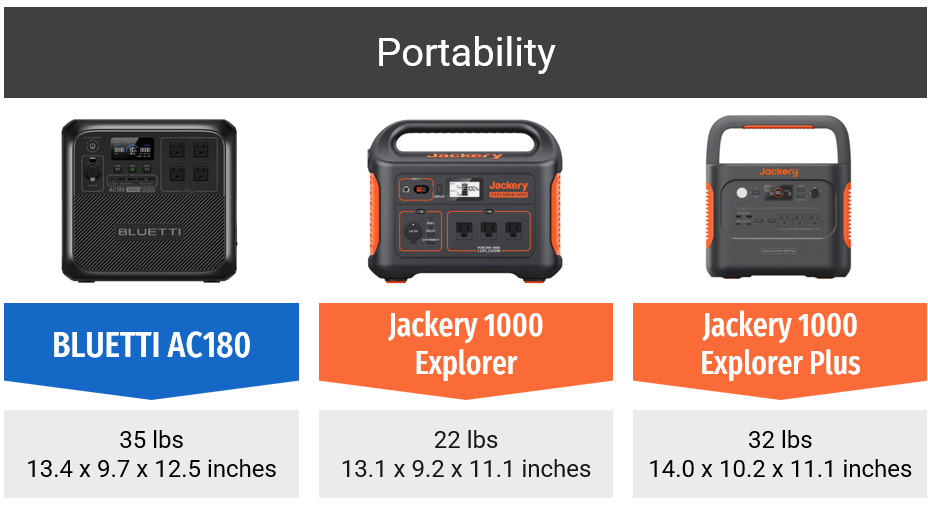
The Bluetti AC180 is the heaviest of the three, weighing about 35.3 lbs (16 kg), with dimensions of 13.39 x 9.72 x 12.48 inches (340 x 247 x 317 mm). While this makes it a little less portable than some lighter models, it is still very manageable, and although it lacks the same carrying handles as the Jackery units, it has hand slots in the top for carrying short distances.
In typical Jackery fashion, the Explorer 1000 and 1000 Plus are more user-friendly in terms of portability, being both lighter and smaller than the Bluetti AC180, and with more convenient handle design.
The Jackery Explorer 1000 is more lightweight and compact than the AC180, making it highly portable for a variety of outdoor and emergency scenarios. It weighs 22 lbs (10 kg) and measures 13.1 x 9.2 x 11.1 inches (333 x 233 x 283 mm). It also has a large built-in carrying handle which makes it very easy to carry.
Largely due to its different battery type, the Jackery Explorer 1000 Plus is a bit larger and heavier than its counterpart, weighing 32 lbs (14.5 kg) and measuring 14 x 10.24 x 11.14 inches (356 x 260 x 283 mm). Despite the increase in weight and size, the design also includes a sturdy and comfortable handle.
Durability
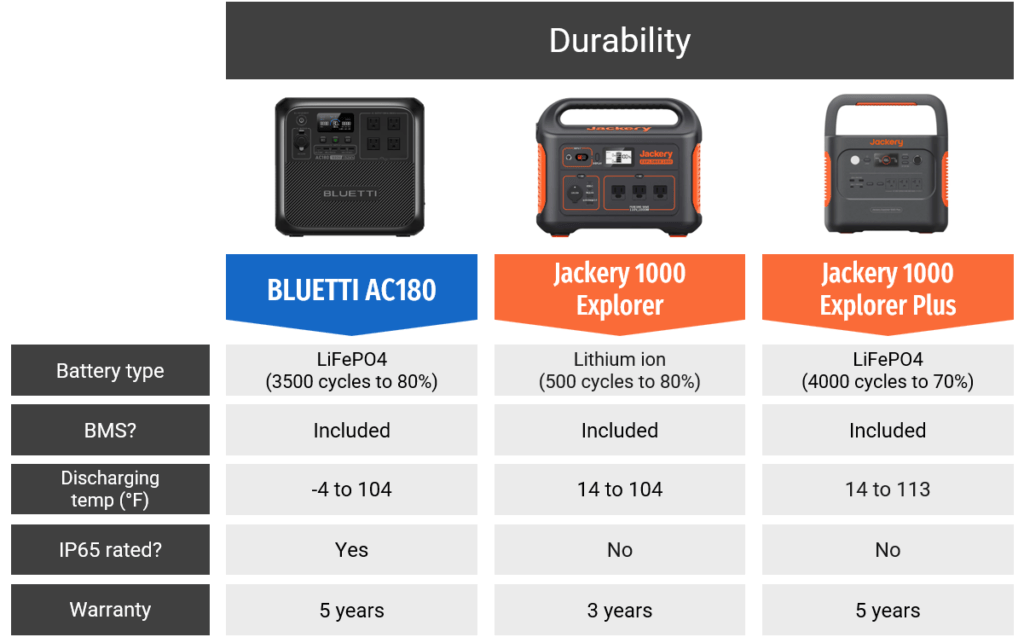
Bluetti AC180
As mentioned previously, the Bluetti AC180 uses a LiFePO4 battery that is well-regarded for its stability and long life span. And, as with most portable power stations, the AC180 includes a battery management system comprising an MPPT solar charge controller, which ensures optimal performance and safety.
It operates safely within a broad temperature range, accommodating charging temperatures from 32°F to 104°F (0°C to 40°C) and discharging temperatures from -4°F to 104°F (-20°C to 40°C), although maximum output is limited to 1500W when temperatures rise between 86°F to 104°F (30°C to 40°C). Therefore it can be used to power appliances in cold temperatures, but should not be charged in freezing conditions.
Its certifications include UKCA, PSE, TELEC, RCM, CE, CA65, and UL Standard, and it is IP65 rated, meaning that whilst it isn’t waterproof, it is splash and dust resistant. It should not be kept in a humid or damp place for a long time.
Finally, the AC180 also comes with a five-year warranty, which is as long as it gets when it comes to power stations.
Jackery Explorer 1000
Unlike the other two models we’re comparing, the Jackery Explorer 1000 uses a lithium-ion battery, which isn’t as stable and long-lasting as the LFP variety. However it still comes with a comprehensive battery management system, over-voltage protection, and short circuit protection.
It is designed to operate within a temperature range of 14°F to 104°F (-10°C to 40°C). We don’t know exactly how the recommended range differs for charging vs discharging, but we would follow the same recommendations as the Bluetti AC180 in this instance. It should also be kept away from humid/damp environments.
The Explorer 1000 comes with a 3-year warranty (2 years plus an extra year for purchasing from the Jackery website).
Jackery Explorer 1000 Plus
The Jackery Explorer 1000 Plus also uses a LiFePO4 battery, with its superior safety and extended cycle life. It includes similar protective features as the Explorer 1000, such as a BMS, over-voltage protection, and short circuit protection, but extends the operating temperature range to 14°F to 113°F (-10°C to 45°C), offering a slightly greater tolerance to environmental variations.
It has an extended 5-year warranty (3 years standard, plus the 2 additional years from purchasing direct from Jackery).
Ease of Use and Display Interface
Bluetti AC180
The Bluetti AC180 emphasizes an intuitive user experience through its sophisticated display and control interface. Here are its standout features:
-
- Advanced LCD Display: The AC180 is equipped with a large, clear LCD screen that provides detailed information at a glance, including battery level, input/output power, and remaining charge time. This comprehensive display ensures users can easily monitor and manage their power usage. Furthermore, it is compatible with smart app control, allowing you to easily monitor its performance.
-
- User-Friendly Controls: Beyond its display, the AC180 features straightforward, easy-to-navigate controls. Users can effortlessly switch between different power outputs and settings, making it simple to optimize the device for various power needs.
-
- Safety Features: With built-in safety mechanisms such as overvoltage, overload, and temperature protections, the AC180 is designed not just for ease of use but also for peace of mind, ensuring a safe experience for all users.
Jackery 1000
The Jackery 1000 takes a slightly different approach, focusing on simplicity and efficiency to cater to users who may not require the advanced functionalities of the AC180. Here’s what makes the Jackery 1000 stand out:
-
- Straightforward LCD Display: The Jackery 1000’s display is designed to be simple, showing essential information such as battery percentage, incoming and outgoing power, and an estimate of the remaining run time. This allows users to quickly understand their power situation without the need for complex interpretation. The fact the Jackery Explorer 1000 can be operated without a smart phone is also a big win for many customers.
-
- Ease of Operation: With a clear and concise control panel, the Jackery 1000 makes it easy to access its features. Its interface is intuitive, allowing for hassle-free operation even for those new to portable power stations.
-
- Portable Design for Easy Use: The lighter weight and compact design of the Jackery 1000 enhance its usability, as it can be easily moved and set up anywhere, providing a seamless user experience for casual outings, emergency power backup, or small outdoor events.
Range of Use: Outdoor, Emergency, and Home Backup
The versatility of a portable power station significantly determines its value, offering solutions not just for outdoor adventures but also for emergency situations and home backup needs. The Bluetti AC180 vs Jackery 1000, with their distinct features and capacities, cater to a broad spectrum of applications, each fitting into different niches of the portable power market.
Bluetti AC180: All-Rounder for Extensive Needs
The Bluetti AC180’s robust capacity and output make it an all-rounder, capable of serving a wide range of applications:
-
- Outdoor Adventures: Its substantial battery capacity and multiple output ports allow the AC180 to power everything from camping essentials to more significant appliances, making it ideal for RVing, camping, and outdoor events where power needs are high.
-
- Emergency Power: The AC180’s high power output and capacity provide a reliable power source during emergencies, capable of running vital home appliances like refrigerators, medical devices, and lights for extended periods.
-
- Home Backup: Beyond emergencies, the AC180 serves as an excellent home backup system, capable of handling high-demand home appliances and power tools, ensuring that your household remains operational during outages.
Jackery 1000: Compact Companion for Everyday Use
The Jackery 1000, while slightly less powerful, offers portability and convenience for a variety of uses:
-
- Outdoor Activities: Its lightweight design and efficient power output make the Jackery 1000 perfect for camping, tailgating, and other outdoor activities where portability and power for smaller devices and appliances are key.
-
- Emergency Situations: The Jackery 1000 can power essential devices and small appliances during power outages, such as phones, lamps, and small medical devices, ensuring safety and connectivity.
-
- Home Backup for Essentials: While not suited for running large appliances for extended periods, the Jackery 1000 can serve as a backup for charging electronic devices and powering small essentials, adding a layer of convenience and security to your home power solutions.
Bluetti AC180 vs Jackery 1000: Conclusion and Final Recommendations
In comparing the Bluetti AC180 and the Jackery 1000, we’ve explored various facets from battery capacity and power output to design, portability, ease of use, and price. Each model serves distinct user needs, preferences, and budgetary considerations. Here’s a final breakdown to guide your decision:
Bluetti AC180: The Powerhouse for Extensive Use
The Bluetti AC180, priced at £749.00 (£1,099 at full price), is a robust portable power station designed for users who require a high-capacity, versatile power solution. Its significant power output, advanced battery technology, and durability make it suitable for a wide range of applications, including extensive outdoor activities, emergency power backup, and even as a reliable home backup power source. Its higher price point is justified by its superior capacity, longevity, and versatility, making it an excellent investment for those with demanding power needs.
Recommended for:
-
- Individuals requiring extended power supply for multiple or high-demand devices.
-
- Those seeking a durable, reliable solution for both outdoor adventures and emergency home backup.
-
- Users who prioritize battery life and versatility in their portable power station.
Jackery 1000: Compact, Convenient, and Cost-Effective
At £599.00 (£1,049 at full price), the Jackery 1000 offers a balance of efficiency, portability, and affordability. It caters well to everyday power needs, providing reliable power for camping, outdoor events, and emergency situations without the bulk or complexity of higher-capacity units. Its ease of use, combined with a solid build and safety features, makes it a great companion for those prioritizing convenience and portability over extensive power requirements.
Recommended for:
-
- Casual users and weekend adventurers needing power for smaller devices and appliances.
-
- Individuals looking for a budget-friendly option without compromising on reliability and ease of use.
-
- Those who value lightweight design and simplicity for immediate power needs.
Making Your Choice
Your decision between the Bluetti AC180 vs Jackery 1000 should hinge on your specific power requirements, the importance of portability, and how much you’re willing to invest. If your activities or emergency power needs demand a high-capacity, versatile power station, and you view it as a long-term investment, the Bluetti AC180 is the optimal choice. Conversely, if you seek a more affordable, user-friendly option for less demanding applications, the Jackery 1000 will serve you well.
Both models stand out in their respective categories, offering reliable power solutions tailored to different user needs. Ultimately, your choice should align with your lifestyle, power requirements, and budget, ensuring that you have the right portable power station to support your adventures, work, and safety in any situation.
Want more comparisons? Check out our brand comparison of Bluetti vs Jackery, or Renogy vs Victron.


